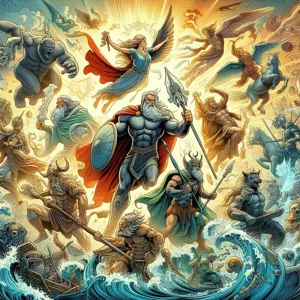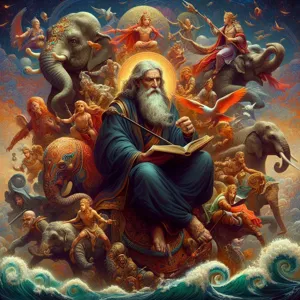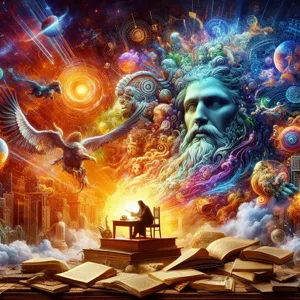Gazing up at the night sky, with its twinkling stars and vast expanse, has always sparked a sense of wonder and curiosity in humanity.
For millennia, ancient cultures have looked to the heavens for guidance, inspiration, and meaning, weaving intricate tales around the constellations that grace our skies. These celestial patterns not only served as navigational tools for explorers but also as the backdrop for rich mythologies and cultural narratives that reflect the values, beliefs, and dreams of civilizations long past. In this blog post, we will embark on a journey through time and space, exploring the fascinating origins of the constellations, the stories that gave them life, and their enduring significance in our understanding of the universe. Join us as we unlock the mysteries of the night sky and discover how these starry formations continue to captivate our imaginations and connect us to the cosmos.
1. Introduction to Constellations
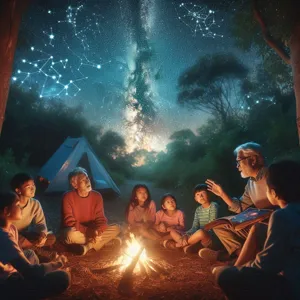
The night sky, a vast expanse of shimmering stars, has captivated human imagination for millennia. Constellations, the recognizable patterns formed by groups of stars, serve as celestial maps that have guided sailors, inspired poets, and ignited the curiosity of astronomers throughout history. Each constellation carries with it a unique story, rooted in the cultures and mythologies of ancient civilizations, offering a glimpse into how our ancestors viewed the cosmos.
In essence, constellations function as a tapestry woven from the threads of mythology, science, and art. The word “constellation” itself originates from the Latin “constellatio,” meaning “set of stars.” This linguistic heritage hints at the intrinsic relationship between humans and the stars above. Ancient peoples looked to the heavens not just for navigation, but also for storytelling; they assigned names, characteristics, and narratives to the stars that formed these celestial groupings.
From the bold hunter Orion, with his iconic belt, to the gentle waters of Aquarius pouring forth, each constellation tells a tale that reflects the values, beliefs, and experiences of the cultures that named them. The Greeks, for instance, saw their deities and heroes in the stars, while Indigenous peoples around the world interpreted the night sky through the lens of their natural surroundings and spiritual beliefs.
As we delve deeper into the world of constellations, we will explore their historical significance, the science behind their formation, and the rich tapestry of stories that accompany them. whether you are an amateur stargazer or a seasoned astronomer, understanding constellations opens a window to the past and invites us to ponder our place in the universe. Join us as we embark on a journey through time and space, unlocking the mysteries and magic that lie within the night sky.
2. The Historical Significance of Constellations
Constellations have long served as more than just beautiful arrangements of stars in the night sky; they are woven into the very fabric of human history and culture. From ancient civilizations to modern astronomers, these celestial patterns have held significant importance, guiding navigation, influencing agriculture, and shaping mythology.
In ancient Mesopotamia, for example, astronomers meticulously mapped the stars, correlating them with seasonal changes that dictated the agricultural calendar. The appearance of certain constellations heralded the right time for planting and harvesting, establishing a rhythm of life tied to the cosmos. Similarly, the Egyptians revered the constellation Orion, associating it with Osiris, the god of the afterlife, and aligned their pyramids with the stars, emphasizing the belief that the afterlife was closely connected to the heavens.
Cultures around the globe have crafted their own stories and interpretations of constellations. The Greeks immortalized their myths through the stars, with tales of heroes, gods, and monsters etched into the night sky. The famous constellation of Ursa Major, for instance, is linked to the myth of Callisto, a nymph transformed into a bear, whose story continues to be told through the stars that shine brightly overhead.
In many indigenous cultures, constellations were essential for storytelling, imparting lessons and wisdom through generations. The Aboriginal peoples of Australia, for example, view the stars as a map of their ancestral stories, with each constellation representing a piece of their heritage and identity.
Today, the historical significance of constellations remains relevant as we explore our place in the universe. They serve as a bridge between our ancestral past and the scientific understandings of the present, reminding us of the shared human experience of gazing up at the night sky, searching for meaning among the stars. As we appreciate the beauty and complexity of these celestial patterns, we also celebrate the rich tapestry of human culture and the stories that have shaped our understanding of the cosmos.
3. Ancient Civilizations and Their Star Lore
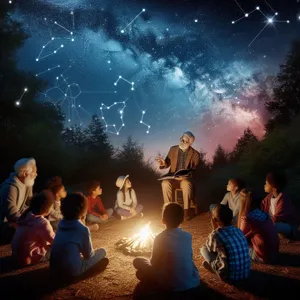
The night sky has always been a source of wonder and inspiration for humanity, and ancient civilizations were no exception. As they gazed up at the stars, our ancestors sought to make sense of the cosmos, weaving intricate stories and myths that explained the celestial phenomena surrounding them. Each civilization, influenced by its unique culture, geography, and beliefs, crafted its own star lore, transforming mere points of light into rich narratives that connected the earthly realm to the divine.
In ancient Mesopotamia, for instance, the Sumerians were among the first to map the night sky, creating one of the earliest known star catalogs. They identified constellations that represented their deities and heroes, attributing agricultural cycles and seasonal changes to the movements of these celestial bodies. The famous Epic of Gilgamesh, a tale of adventure and friendship, featured the stars as guiding forces, illustrating how the ancients saw themselves as part of a larger cosmic narrative.
Meanwhile, the ancient Egyptians looked to the heavens for guidance and reassurance. They revered the constellation Orion, associating it with Osiris, the god of the afterlife. The alignment of the pyramids with the stars was no coincidence; it reflected their belief in the connection between the pharaohs and the divine. The heliacal rising of Sirius, marking the annual flooding of the Nile, was celebrated with festivals that signaled the start of their agricultural calendar.
On the other side of the globe, the indigenous peoples of North America crafted their own star stories, rich with symbolism and life lessons. The Lakota Sioux, for example, viewed the Milky Way as a river of stars, a pathway for souls to journey to the afterlife. Their constellations told tales of animals, hunters, and celestial events, reinforcing their connection to nature and the cycles of life.
Even in ancient Greece, where astronomy flourished, the stars were imbued with mythological significance. The Greeks named constellations after their gods and heroes, from the mighty Orion to the enchanting Pleiades. These stories not only served as a means of navigation but also as a way to impart moral lessons and cultural values to generations.
As we delve into the star lore of these ancient civilizations, we uncover a tapestry of human experience—a reflection of our collective desire to understand our place in the universe. Each constellation serves as a reminder of the dreams, fears, and aspirations of those who came before us, bridging the gap between the earthly and the celestial, and inviting us to continue looking up in wonder at the night sky.
4. The Mythological Origins of Major Constellations
The night sky has long been a canvas for stories, with each constellation serving as a window into the mythology and beliefs of ancient civilizations. These celestial patterns were not merely clusters of stars; they were vivid narratives that connected the heavens to the Earth, often reflecting the cultures and values of the people who gazed upon them.
Take, for instance, Orion, one of the most recognizable constellations. In Greek mythology, Orion was a great hunter, known for his strength and prowess. His tale is intertwined with those of other celestial beings, including the Pleiades, the seven daughters of Atlas, who were transformed into stars to escape Orion’s relentless pursuit. This story, filled with themes of adventure and danger, gave meaning to the patterns in the sky, allowing ancient Greeks to find comfort and connection in the vastness above.
Similarly, Ursa Major and Ursa Minor, known as the Great Bear and the Little Bear, have origins steeped in myth. The Greeks associated these constellations with the story of Callisto, a beautiful maiden turned into a bear by the goddess Artemis. Her son, Arcas, unknowingly hunted her until Zeus intervened, placing them both in the sky to ensure they would never be apart again. This poignant tale of love and loss has resonated through the ages, enriching the night sky with depth and emotion.
In addition to Greek lore, many cultures have their own interpretations of the same stars. The Mesoamerican civilizations, for example, viewed the constellation of Orion as a powerful hunting figure, while the Indigenous peoples of North America saw different animals and spirits in the same arrangement, each with their own unique stories and lessons.
These mythological origins of major constellations not only provide a glimpse into the beliefs of our ancestors but also invite us to reflect on our own place in the universe. As we look up at the stars, we are reminded that the stories written in the sky are as timeless as the stars themselves, binding us to a shared human experience that transcends generations and cultures. Unlocking the night sky invites us to explore these narratives, offering a deeper appreciation for the beauty and mystery that surrounds us.
5. How Constellations Were Used for Navigation
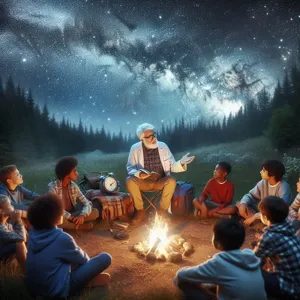
Throughout history, constellations have served as more than just celestial decorations; they have been vital tools for navigation, guiding countless explorers, sailors, and travelers across vast and often treacherous landscapes. Ancient civilizations, from the mariners of the Mediterranean to the Indigenous peoples of North America, looked to the night sky for direction, using the stars as their compass.
One of the most famous navigational constellations is Ursa Major, which houses the well-known Big Dipper asterism. This formation acts as a celestial guidepost, its two outer stars, Dubhe and Merak, pointing directly to Polaris, the North Star. For centuries, sailors relied on this unchanging beacon to establish their northern orientation, especially in open waters where terrestrial landmarks were absent.
Similarly, the Southern Cross constellation served as an essential navigation aid in the southern hemisphere. Its distinctive cross shape enabled navigators to locate true south, making it invaluable for explorers venturing into the unknown territories of the South Pacific and beyond.
But constellations were not just limited to maritime navigation. Indigenous tribes around the world used the stars to chart their paths across land. The Māori of New Zealand, for example, utilized the Matariki cluster to signal the arrival of the New Year, guiding their planting and harvesting cycles.
As technology advanced, the reliance on constellations for navigation evolved, yet their significance remains embedded in our cultural consciousness. From the tales of ancient sailors sailing into uncharted waters to the modern-day adventurers using apps that connect them to the cosmos, the stories of constellations continue to inspire and guide us, reminding us of our enduring connection to the night sky.
6. The Role of Constellations in Agriculture and Timekeeping
Constellations have served humanity far beyond their aesthetic appeal and mythological narratives; they have played a crucial role in agriculture and timekeeping throughout history. Ancient civilizations understood that the night sky was not just a canvas of twinkling stars but a vital tool for survival, helping to navigate the rhythms of the natural world.
For agrarian societies, the appearance of specific constellations marked the changing of the seasons, signaling the optimal times for planting and harvesting crops. For instance, the rise of the Pleiades, a prominent cluster of stars in the constellation Taurus, heralded the arrival of spring in many cultures, prompting farmers to till their fields and sow seeds. Similarly, the heliacal rising of Orion was used by the ancient Egyptians to predict the annual flooding of the Nile, a critical event that ensured fertile land and a bountiful harvest. These celestial markers provided a calendar that was intricately tied to the earth’s cycles, allowing communities to thrive in harmony with nature.
Moreover, constellations served as timekeepers, guiding not only agricultural practices but also daily life. The changing positions of stars throughout the year helped people determine the time of night and, by extension, the time of year. Cultures around the globe created sophisticated systems for tracking time based on celestial movements, leading to the development of early calendars. The Māori of New Zealand, for instance, used the stars to navigate their way across oceans and to govern their seasonal activities, while the ancient Greeks relied on constellations to mark important dates in their civic calendars.
As we gaze up at the night sky today, we can appreciate the rich tapestry of knowledge and tradition woven through the constellations. They remind us that our ancestors looked to the heavens not just for wonder, but for guidance, ensuring that the cycles of agriculture and the passage of time were understood and respected. This deep connection between the stars and human life underscores the timeless significance of constellations in our cultural heritage.
7. The Development of Modern Constellation Maps
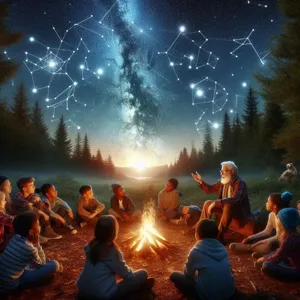
The development of modern constellation maps represents a fascinating evolution from ancient stargazing practices to sophisticated celestial navigation. In the early days, humans gazed up at the night sky, identifying patterns and shapes that would later evolve into the constellations we recognize today. Ancient civilizations, such as the Babylonians and Egyptians, meticulously recorded their observations and created rudimentary star maps, often linking celestial bodies with mythological tales and agricultural cycles.
As time progressed, the art of mapping the heavens underwent significant refinement. During the Renaissance, astronomers like Johannes Hevelius and Nicolas Copernicus began to challenge existing paradigms, introducing more accurate measurements and a systematic approach to cataloging stars. The invention of the telescope further revolutionized our understanding of the night sky, allowing for the detailed observation of celestial phenomena that were previously invisible to the naked eye.
The modern constellation maps we use today are largely based on the work of the 18th-century astronomer Johann Bayer, who introduced the use of Greek letters to denote star brightness within a constellation. This system, along with the realistic depictions of constellations created by artists such as Andreas Cellarius, helped standardize the way we visualize the night sky. The International Astronomical Union (IAU) later formalized 88 constellations in the early 20th century, providing a universal reference that transcends cultural boundaries.
Today, constellation maps serve not only as a tool for astronomers and navigators but also as a source of inspiration for storytellers and dreamers. With advancements in technology, we can now explore the cosmos through digital applications that overlay constellations onto our real-time sky, allowing anyone to unlock the mysteries of the night and connect with the age-old stories woven among the stars. Whether you’re an avid stargazer or a curious beginner, the journey of understanding constellations is a testament to humanity’s enduring fascination with the universe.
8. Famous Constellations and Their Stories
The night sky is a canvas of wonder, painted with ancient myths and celestial tales. Among the most famous constellations, each holds a story that has captivated humanity for centuries. Let’s explore some of these iconic patterns and the legends that breathe life into them.
**Orion**: Often referred to as the Hunter, Orion is one of the most recognizable constellations. According to Greek mythology, Orion was a giant huntsman who boasted that he could kill any beast on Earth. His arrogance angered the goddess Artemis, who sent a scorpion to defeat him. The result was a cosmic chase—Orion is forever pursued by the Scorpius constellation across the night sky, a poignant reminder of humility in the face of nature’s power.
**Ursa Major**: Known as the Great Bear, this constellation is home to the famous asterism, the Big Dipper. In various cultures, Ursa Major has been seen as a symbol of strength and guidance. Indigenous peoples of North America often viewed the Big Dipper as a group of hunters chasing a bear, signifying the balance between humanity and the wild. Its stars have served as a navigational tool, guiding travelers through the darkness for centuries.
**Cassiopeia**: This constellation is easily identifiable by its distinctive W shape. Cassiopeia, the vain queen, was known for her beauty and pride. Her story warns against hubris, as she boasted that she and her daughter, Andromeda, were more beautiful than the sea nymphs, leading to dire consequences for her kingdom. To appease the sea god Poseidon, Andromeda was chained to a rock as a sacrifice, only to be saved by the hero Perseus. The tale of Cassiopeia serves as a reminder of the fine line between confidence and arrogance.
**Leo**: Representing the Lion, Leo is associated with the Nemean Lion, a ferocious beast slain by Hercules as one of his twelve labors. Its impenetrable hide made it nearly invincible, symbolizing bravery and strength. In the night sky, Leo’s stars remind us of the heroic deeds that have shaped human history and the perennial struggle against formidable challenges.
**Taurus**: This constellation represents the Bull, often linked to the myth of Zeus who transformed into a magnificent bull to win the love of Europa. With its prominent cluster of stars known as the Hyades and the bright Pleiades, Taurus has been a significant symbol in various cultures, representing fertility, strength, and the cycles of nature. The ancient Greeks revered it as a harbinger of spring, a time of renewal and growth.
Each of these constellations is a gateway to understanding our ancestors’ worldview, their values, and the stories that have shaped cultures across the globe. As we gaze up at the night sky, let us not only admire the beauty of these stellar formations but also reflect on the rich tapestry of legends that enrich our understanding of the cosmos and our place within it.
9. The Influence of Constellations on Art and Literature
The influence of constellations on art and literature is a captivating testament to humanity’s enduring fascination with the night sky. Throughout history, the stars have served as more than just celestial markers; they have inspired countless creative expressions that weave together the realms of imagination, symbolism, and the human experience.
From ancient cave paintings to modern digital art, the constellations have provided artists with a rich tapestry of themes to explore. The iconic shapes and stories embedded in the constellations have inspired painters like Vincent van Gogh, whose swirling night skies in “Starry Night” evoke a sense of wonder and connection to the cosmos. Similarly, contemporary artists continue to draw on celestial imagery, using constellations as metaphors for exploration, dreams, and the infinite possibilities that lie beyond our earthly existence.
In literature, constellations have sparked the imagination of poets, playwrights, and novelists alike. The stories of ancient mythologies—such as the tale of Orion the Hunter or the tragic love story of Pleiades—have been woven into the fabric of countless narratives, enriching the themes of love, loss, and the eternal struggle between fate and free will. Shakespeare, for instance, often referenced the stars in his works, using them as symbols of destiny and human emotion.
Moreover, constellations have played a crucial role in guiding explorers and adventurers throughout history. Authors like Mark Twain and Jack London incorporated celestial navigation into their tales, illustrating the way the stars have been guiding lights for those who dare to venture into the unknown.
The influence of constellations extends beyond mere inspiration; they invite us to ponder our place in the universe. In a world increasingly dominated by technology and digital distractions, looking up at the night sky and contemplating the constellations can remind us of the timeless stories that connect us to our ancestors and to one another. Whether through brushstrokes on a canvas or the lyrical flow of a poem, the constellations continue to shine brightly in the collective consciousness of humanity, urging us to reflect, dream, and create.
10. Cultural Variations in Constellation Interpretations
The night sky, a vast tapestry of stars, has long been a source of wonder and inspiration across cultures. While the constellations may appear as a series of patterns from our vantage point on Earth, different civilizations have woven their unique narratives and meanings into these celestial formations. The interpretations of the same group of stars can vary dramatically depending on cultural context, history, and geography.
For instance, in Western astronomy, Orion is often depicted as a mighty hunter, with his belt of three bright stars symbolizing strength and prowess. In contrast, the ancient Greeks saw him as a symbol of beauty and a figure of myth, while Aboriginal Australians viewed the same constellation as a group of women gathering food, reflecting their rich storytelling traditions and deep connection to the land.
Similarly, the Big Dipper, part of the Ursa Major constellation, holds various significances across different societies. In North America, it has been utilized as a navigational tool, guiding travelers and explorers. Meanwhile, in Chinese astronomy, it is known as the “Northern Dipper” and is associated with the agricultural calendar, signifying the changing seasons.
These cultural variations highlight not only the diversity of human experience but also the shared fascination with the cosmos. As we gaze up at the stars, we engage in a timeless dialogue with our ancestors—each constellation a chapter in the greater story of humanity’s quest to understand the universe. By exploring these diverse interpretations, we not only enrich our appreciation of the night sky but also celebrate the myriad ways in which cultures have sought to make sense of the world around them. Ultimately, the constellations serve as a reminder that while the stars may be constant, our perceptions of them are as varied and vibrant as the tapestry of human culture itself.
11. The Science Behind Constellations: Stars and Distances
The night sky, a vast canvas dotted with shimmering lights, has captivated humanity for millennia. But beyond their ethereal beauty, constellations tell stories rooted in both mythology and science. To truly appreciate these celestial formations, it’s essential to understand the science behind them—the stars they comprise and the distances that separate them.
When we gaze at a constellation, we are often looking at stars that are not only light-years apart but also vastly different in size, brightness, and distance from Earth. For instance, the iconic Orion, with its prominent belt of three stars, features Rigel and Betelgeuse. Rigel, a blue supergiant, is approximately 860 light-years away, while Betelgeuse, a red supergiant nearing the end of its life, sits about 642 light-years distant. This means that the light we see from these stars today actually left them many centuries ago, offering a glimpse into the universe’s past.
Moreover, the stars within a constellation may not be physically related at all. They may merely appear grouped together from our vantage point on Earth, while in reality, they could be scattered across the cosmos. This phenomenon, known as “optical alignment,” is a reminder of the vastness of space and the intricate three-dimensional tapestry of the universe.
Understanding the distances between stars not only enriches our appreciation of constellations but also enhances our grasp of astronomical concepts like parallax—the apparent shift of an object against a distant background due to a change in the observer’s position. It’s through this scientific lens that we begin to unlock the deeper mysteries of the night sky, discovering how these ancient patterns connect us to the universe and to the stories our ancestors crafted under the same stars. As we continue to explore and study these celestial wonders, we gain insight not just into the cosmos, but also into our own place within it.
12. How to Observe and Identify Constellations Today
Observing and identifying constellations today is an enchanting blend of modern technology and timeless tradition. With the vastness of the night sky as your canvas, you can embark on a celestial journey that has captivated humanity for centuries.
First, it’s essential to choose the right location for your stargazing adventure. Seek out a spot away from the bright lights of urban areas, where the stars can shine in all their glory. A clear night with minimal cloud cover is ideal, and the best time to observe constellations is during the months of spring and summer when the skies are often clearer.
Once you’re settled in, consider using a star chart or an astronomy app on your smartphone. These tools can guide you in identifying constellations and their respective stars. Many apps utilize augmented reality, allowing you to point your device at the sky and instantly see the names of constellations and stars overlaying the view. This interactive experience not only enhances your understanding but makes stargazing more engaging.
For a more traditional approach, familiarize yourself with a few key constellations to start. Orion, with its distinctive belt of three bright stars, is an excellent starting point for beginners. Once you’ve located Orion, you can easily find other constellations nearby, such as Taurus and Canis Major. Remember to look for the Big Dipper, which acts as a celestial guidepost leading you to the North Star, Polaris.
As you observe, take note of the star patterns and their positions in relation to each other. Consider bringing along binoculars or a small telescope to get a closer look at individual stars, clusters, or even distant galaxies.
Finally, keep a journal of your observations. Documenting your stargazing experiences not only enriches your connection to the night sky but also allows you to track your progress in identifying different constellations over time.
By combining modern tools with a sense of wonder and curiosity, you can unlock the secrets of the night sky and forge your own stories among the stars.
13. The Future of Constellations in a Light-Polluted World
As we gaze up at the twinkling tapestry of stars, it’s hard not to be captivated by the constellations that have guided explorers, inspired myths, and sparked our curiosity for millennia. Yet, in our modern world, the future of these celestial formations hangs in a delicate balance, overshadowed by the ever-increasing glow of artificial light. Light pollution has become a pressing issue, obscuring our view of the night sky and diminishing our connection to the cosmos.
In urban areas, where streetlights and skyscrapers illuminate the darkness, the once-clear outlines of constellations fade into a hazy blur. The familiar patterns that once served as navigation tools and storytelling canvases are becoming harder to discern, leading to a disconnection from the narratives that have woven through human history. Children growing up in these light-saturated environments may never know the thrill of spotting Orion’s Belt or the serene beauty of the Big Dipper.
However, all is not lost. The growing awareness of light pollution has sparked a movement towards dark sky preservation. Organizations and enthusiasts are advocating for better lighting practices, such as using shielded fixtures and warmer light temperatures that minimize skyglow. These efforts aim to restore our night skies, allowing future generations to experience the magic of stargazing as it was meant to be.
Moreover, technology is stepping in to bridge the gap. Smartphone apps and digital planetariums are making it easier than ever to learn about constellations, even in light-polluted areas. These tools provide detailed maps of the night sky, guiding users through the stories and scientific wonders above them. While the physical view may be obscured, the digital realm offers a new way to connect with the stars.
As we look to the future, it’s crucial to balance our desire for progress with our need for connection to the universe. By advocating for dark skies and utilizing technology thoughtfully, we can ensure that the stories behind the constellations will not only endure but thrive, illuminating the minds and hearts of those who gaze upward, even in a brightly lit world.
14. Engaging with Constellations: Apps and Resources
In today’s digital age, connecting with the night sky has never been easier, thanks to a plethora of apps and resources designed to enhance our understanding of constellations and the stories they tell. From stargazing novices to seasoned astronomers, there’s a tool available for everyone that can transform a simple evening under the stars into an immersive educational experience.
One of the most popular options is stargazing apps, which utilize augmented reality to overlay constellation outlines onto your smartphone screen. Apps like Star Walk, SkyView, and Night Sky allow users to point their devices at the sky, instantly identifying stars, planets, and constellations, while providing rich details about their mythology and astronomical significance. With just a simple tap or swipe, you can delve into the history of Orion, discover the tales behind Ursa Major, or learn about the celestial coordinates of your favorite star clusters.
For those who prefer a more traditional approach, numerous websites and online resources offer comprehensive guides and interactive sky maps. Websites like Sky & Telescope and NASA’s Night Sky Network provide educational articles, seasonal guides, and interactive tools that can deepen your knowledge and appreciation of the cosmos. These platforms often host online forums, allowing stargazers to share their experiences, ask questions, and connect with a community of fellow enthusiasts.
Additionally, social media platforms and YouTube channels dedicated to astronomy can serve as inspirational resources. Engaging content, such as live streams of celestial events, tutorials on astrophotography, and discussions about the latest discoveries, can ignite your passion for the night sky and keep you informed about upcoming astronomical phenomena.
Whether you’re gazing up from your backyard or venturing into a dark sky reserve, these apps and resources can enhance your connection to the constellations. They not only provide a gateway to the stars but also invite you to explore the myths and legends that have captivated humanity for centuries, ensuring that our fascination with the cosmos continues to thrive in the modern world.
15. Conclusion: The Enduring Legacy of the Night Sky
The night sky has been a source of wonder and inspiration for humanity since time immemorial. As we draw this exploration of the constellations to a close, it’s essential to reflect on their enduring legacy. These celestial patterns, etched into the fabric of the universe, have served as navigational guides for travelers, calendars for agricultural societies, and mythological backdrops for countless stories across cultures.
From the ancient Babylonians who mapped the stars to the indigenous peoples who imbued them with meaning, constellations have been a bridge between the heavens and our earthly existence. They whisper the tales of heroes, gods, and monsters, reminding us of our place in the cosmos and the shared human experience across different civilizations and epochs.
As we gaze up at the star-studded sky, we connect with generations of dreamers who looked up in awe and wonder, asking the same questions: What lies beyond? Are we alone in this vast universe? The constellations invite us to ponder our origins and inspire us to reach for the unknown.
In a world increasingly dominated by technology and urban light pollution, the constellations remind us of the simple beauty of nature and our intrinsic connection to it. By learning the stories behind these celestial formations, we not only honor the knowledge of our ancestors but also reignite our curiosity about the universe.
As we close this chapter on the constellations, let us carry forward their legacy. Let us continue to explore the night sky, to tell stories, and to dream—because every glance upward is a reminder that the universe is vast, full of mysteries, and waiting for us to unlock its secrets. The night sky is not just a canvas of stars; it is a tapestry woven with history, culture, and the eternal quest for understanding.
As we conclude our journey through the starry tapestry of the night sky, we hope you feel a renewed sense of wonder and curiosity about the constellations that have captured human imagination for millennia. From the ancient myths that shaped cultures to the scientific discoveries that expanded our understanding of the universe, each constellation holds a wealth of stories waiting to be explored. Whether you find yourself gazing up at the stars in your backyard or navigating the cosmos with a telescope, remember that these celestial patterns are not just dots of light; they are a bridge connecting us to our ancestors, to history, and to the mysteries of the universe. So, the next time you look up at the night sky, take a moment to reflect on the rich narratives and profound significance behind those twinkling stars. Happy stargazing!

